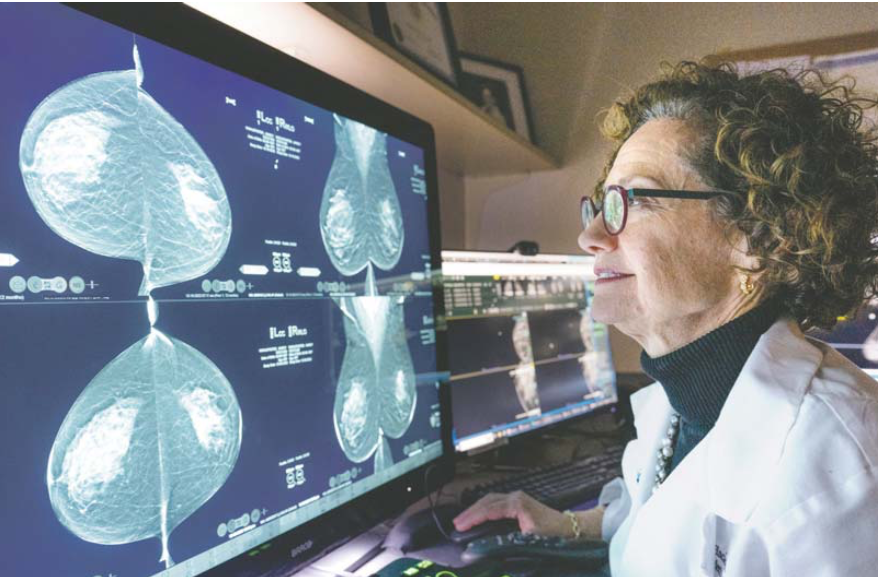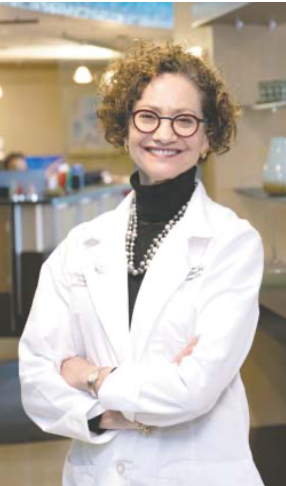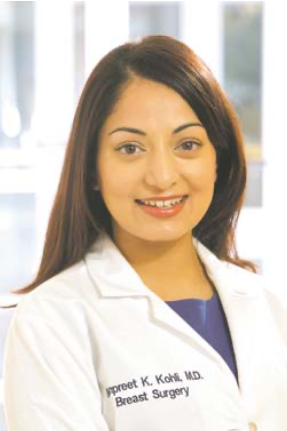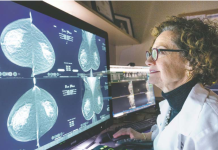
By Jamie Jablonowski, MPH, BSN, RN, CPH
Breast cancer is the second most common cancer, only behind skin cancer, among women in the United States. Over 8,500 women were diagnosed with breast cancer in 2021, according to the latest data from the New Jersey Department of Health (NJDOH), and the disease continues to claim over 1,200 lives annually in the state.
Fortunately, there have been significant strides in breast cancer screening and treatment, with local hospitals incorporating the latest scientific advancements and technologies to enhance patient outcomes.
Manpreet K. Kohli, M.D., director of breast surgery for Monmouth Medical Center, said the field has been able to learn from generations of women and has evolved rapidly. “We get to learn from how people were treated in the past and do better today.”
Catching Breast Cancer Early
Before mammograms became more common in the late 1960s to early 1970s, breast cancer was suspected only after a lump was discovered in breast tissue and could only be diagnosed with surgery. “The patient would wake up either having a breast or not having a breast,” said Kohli. “It’s something very scary for any woman to think of because it’s a huge part of you. It’s not just a body part, but it’s your femininity, your identity. It’s part of raising your children.”
She shared that today, research has shown that lumpectomies are as safe as doing a mastectomy for the right patients with the right treatment plan. If a mastectomy is needed, the reconstructive options have drastically improved, offering women the confidence they won’t feel disfigured following surgery.
Kohli described how breast cancer diagnosis and treatment have become more precise and tailored to the individual patient, creating specialized care plans for women. The first step in this process starts with screening. Mammograms can detect breast cancer before a lump can be felt, allowing for earlier diagnosis. According to the American Cancer Society, breast cancer that is diagnosed early (Stage 1) has a five-year survival rate of 99%, highlighting the importance of early detection.
Harriet Borofsky, M.D., medical director of breast imaging at Hackensack Meridian Riverview Medical Center, said that, due to early detection and the ability to utilize a method of “de-escalation,” there has been an “enormous paradigm shift in the treatment of breast cancer.”
The U.S. Preventive Services Task Force recommends that women who are 40 to 74 years old and are at average risk for breast cancer get a mammogram every two years. Unfortunately, according to the NJDOH, 1 in 5 women in New Jersey are not meeting the current recommendations.
Both Monmouth Medical Center and Riverview Medical Center use the Tyrer-Cuzick Risk Assessment tool to assess if an individual is high risk. Accounting for risk factors such as family history, age, breast density and reproductive factors, the tool calculates a lifetime risk for breast cancer. If a person has a lifetime risk of 20% or greater, Borofsky said that, in addition to a mammogram, an MRI would be recommended in six months. If a person has dense breast tissue, an ultrasound may be recommended in addition to a mammogram. The Tyrer-Cuzick Risk Assessment is available online and the results can be discussed with your doctor to see if early screening is indicated.
Borofsky explained that 3D mammography, also called digital breast tomosynthesis (DBT), is the single most important technological advancement she has seen during her career. This technology provides an image of the breast from multiple angles. At Riverview Medical Center, they are now using 3D mammography with Genius AI. “I will read a mammogram and at the very end I will utilize AI that highlights areas that are being detected as areas of possible abnormality,” explained Borofsky. “Not only does it highlight something on the mammogram, it tells me the percentage probability that it could be cancer.”
This innovative technology can also sort through unread mammograms and identify those that require prioritization for reading. “AI not only enhances or makes me a better radiologist and breast imager, but it also boosts my confidence and my efficiency,” said Borofsky. Implemented in 2024, the efficacy of this technology won’t be known until the 2025 and 2026 data becomes available; however, Borofsky is confident it will result in improved patient outcomes.
Changing Treatment
Since tumors are now being identified earlier and at a smaller size, more aggressive treatment is only required for select patients. “Chemotherapy is now done in a select group of women who are identified as being higher risk for having breast cancer spread or recur,” said Borofsky. “Most women diagnosed with breast cancer do not need chemotherapy. And that is a major change from when I started three decades ago.”
“Treatments are very well tolerated and women can continue with their lives, their work, while they’re being treated for breast cancer, all because of early detection,” said Borofsky.
Kohli said one in 12 women will refuse chemotherapy over hair loss concerns. She explained that scalp cooling treatments are now available at most hospitals in the community to preserve a woman’s hair during treatment. “It’s a really nice thing to be able to offer where you still get the care you need, but without as noticeable a physical change,” said Kohli.
At Monmouth Medical Center, new technology is also being incorporated to prevent a condition called lymphedema. Lymph nodes act as filters, trapping cancer cells, bacteria and debris. The lymph nodes located closest to the breast are sometimes removed to check if the cancer has spread. This can lead to long-term swelling in the arm – called lymphedema – which can impact a woman’s quality of life and daily activities.
Using a liquid dye called MagTrace, surgeons can now identify potentially affected lymph nodes prior to surgery and only remove them if the cancer is found to be invasive, which occurs in only 5% of cases, according to Kohli.
Monmouth Medical Center has also implemented a device called SOZO that uses harmless electrical currents to detect lymphedema, often before symptoms appear, potentially preventing the need for further surgery. Kohli said these new improvements “are the kind of things that we’re really proud that we have at Monmouth, where it’s really impacting not just how we treat the patients in the moment, but their long-term quality of life after they’re done with their cancer care.”
Looking Toward the Future
In general, there is a trend toward less invasive and more personalized patient treatment options. Borofsky sees a trend toward continued de-escalation and targeting treatments for specific tumor profiles. She said Riverview Medical Center is currently looking into a technology called cryoablation, a non-surgical approach to treating very small early-stage breast cancers by using a needle under ultrasound guidance and ice balls to cure and eradicate these small, nonaggressive tumors.
Kohli said she sees promise in AI being able to better visualize the breast tissue during screening. When a patient has a breast MRI, they lie on their stomach on the table, but when they undergo surgery, they are placed on their back. Using AI, the MRI image can be reconstructed to allow surgeons to better visualize the tumor in the position they will be operating.
Passionate about breast cancer and providing the best care for patients, Kohli and Borofsky both highlighted their continued dedication to the field.
“I am inspired every day by the women I meet, by the strength and resiliency of women and how we cope with difficult things, difficult procedures, difficult diagnoses, take charge, move on to get through it to the other side of the mountain and then come back,” said Borofsky. “It amazes me and inspires me every day.”
In addition to Monmouth Medical Center and Riverview Medical Center, comprehensive breast cancer care is also offered at Memorial Sloan Kettering Monmouth in Middletown, offering patients choices for specialized breast care close to home.
The article originally appeared in the October 2 – October 8, 2025 print edition of The Two River Times.
















